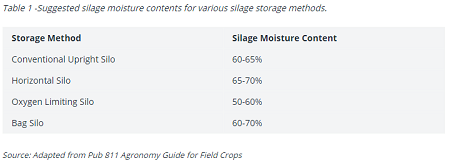CNH Industrial
In many parts of the province, 2019 proved to be a challenging year to get crops in the ground in a timely fashion. The impacts of spring conditions are still felt as we approach harvest and there are concerns about reaching levels of physiological maturity or quality necessary for grain corn harvest (Fig 1). While there are various approaches to managing a late crop, alternative harvest and feeding options for livestock should not be overlooked as a solution. High moisture corn products make excellent feed for livestock, especially ruminants, but the success of using these feedstuffs is dependent on management related to harvest timing, processing, storage conditions and feeding.
High moisture corn
High moisture corn is a nice feed ingredient for livestock producers. The benefit of high moisture corn is that it can be harvested earlier, does not have to be dried and has similar energy and protein levels as dry corn. High-moisture corn can be harvested at 24-36% moisture (optimally 28-32% for proper fermentation) and must be ensiled in upright silos, bunker silos or silage bags. Sealed storage is the best option to reduce spoilage. Processing through rolling or grinding is a necessary step to achieve effective ensiling. A finer particle size leads to better packing, exclusion of oxygen during storage, and reduced risk of spoilage.
From a feeding perspective, high-moisture corn has similar energy and protein content as dry corn but generally has higher digestibility and is more palatable. Finer grind size and higher digestibility increases risk of digestive upsets such as acidosis and this feed ingredient must therefore be managed accordingly. Targeting a uniform grind size that optimizes a reduction of both fine and whole particles is ideal for nutrition and storage reasons.
Cobmeal or Snaplage
Cobmeal, also known as high moisture ear corn or earlage, is closer to corn silage in terms of the way in which it is stored and fed. This feedstuff must be ensiled and is primarily fed to ruminant livestock. Cobmeal is made up of the grain and cob portion of the plant and may include some husks and stalks. It is typically harvested by combine like high moisture corn, but with the combine set to also retain cob. The extent to which husks and stalks are included depends on how it is harvested.
Snaplage is a similar product that is harvested with a snapper header on a forage harvester and includes corn grain, cobs, and husks. Optimal dry matter at harvest is 65% to reduce risk of seepage and spoilage during storage.
The energy level of cobmeal typically falls in between that of corn silage and high moisture corn. Nutrient specifications will vary depending on harvest method, maturity of corn, and other growing conditions. As with other feedstuffs, it is important to test through laboratory analysis before feeding out. Higher maturity and increased inclusion of the shank, husks and stalk will decrease the energy density of the feed. However, the addition of the shank, husks and stalk have the added benefit of containing effective fibre, which helps protect the rumen from acidosis, and increasing overall tonnage captured during grain harvest operations. The amount of effective fibre contained in cobmeal may help reduce the amount of other forage required in the ration to maintain optimal rumen health.
Corn Silage
Corn silage is the obvious alternative to taking off grain corn, however the harvest window for corn silage is less forgiving due to constraints associated with necessary moisture levels for storage. Corn silage must be ensiled to allow for proper fermentation, either through permanent structures or temporary silage bags. If corn silage is not harvested at the optimal maturity and moisture levels, nutritional value is compromised, and storage spoilage becomes a greater risk. Clostridial fermentation, nutrient loss through seepage, reduced yield, and incomplete fermentation are all risks associated with taking off corn silage at high moisture levels (greater than 70% moisture). Poor packing and increased risk of spoilage become a concern when moisture levels are too low at harvest (less than 60% moisture for most storage methods). Suggested moisture contents for various storage methods are presented in Table 1.

If a corn grower is trying to determine if their grain corn field could still be sold and harvested as silage, whole plant moisture samples should be taken. Half to 2/3 milk line progression (from dent end to kernel tip at cob) has traditionally been used as a general indicator for proper whole-plant moisture content for silage harvest, though this is not always reliable and can be influenced by hybrid characteristics (stay green, silage traits), frost damage or moisture stress. Keep in mind that corn affected by frost can appear to be dried down but a whole plant moisture assessment may tell you otherwise. Nitrate accumulation is also of concern after a frost. For more information on frost damaged corn silage, visit
http://www.omafra.gov.on.ca/english/crops/facts/frost_silage.htm.
Remember that corn silage is not the only alternative harvest option. If the conditions are not right for taking corn silage off as a dry grain corn alternative, consider the other options outlined in this article.
Source : Field Crop News